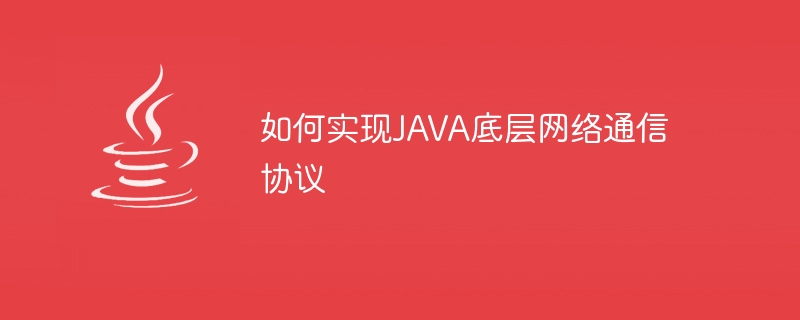

How to implement Java underlying network communication protocol
The network communication protocol is the rules and conventions used to implement data transmission and communication in computer networks. In Java, we can implement network communication protocols through underlying network programming. This article will introduce how to use the Java programming language to implement the underlying network communication protocol and provide specific code examples.
Java provides two classes, Socket and ServerSocket, for implementing the client and server in network communication. The client establishes a connection with the server through Socket and sends a request; the server monitors the client's connection request through ServerSocket and processes the client's request.
The following is a simple code example that demonstrates how to implement a client and server based on the TCP protocol.
First is the server-side code:
import java.io.*;
import java.net.*;
public class Server {
public static void main(String[] args) {
try {
// 创建ServerSocket,并指定端口号
ServerSocket serverSocket = new ServerSocket(8888);
// 监听客户端的连接请求
Socket socket = serverSocket.accept();
// 获取输入流,用于接收客户端发送的数据
InputStream inputStream = socket.getInputStream();
BufferedReader bufferedReader = new BufferedReader(new InputStreamReader(inputStream));
// 获取输出流,用于向客户端发送数据
OutputStream outputStream = socket.getOutputStream();
PrintWriter printWriter = new PrintWriter(outputStream);
// 读取客户端发送的数据
String message = bufferedReader.readLine();
System.out.println("收到客户端的消息:" + message);
// 向客户端发送数据
printWriter.println("Hello, client!");
printWriter.flush();
// 关闭连接
socket.close();
serverSocket.close();
} catch (IOException e) {
e.printStackTrace();
}
}
}Next is the client-side code:
import java.io.*;
import java.net.*;
public class Client {
public static void main(String[] args) {
try {
// 创建Socket,并指定服务器的IP地址和端口号
Socket socket = new Socket("localhost", 8888);
// 获取输出流,用于向服务器发送数据
OutputStream outputStream = socket.getOutputStream();
PrintWriter printWriter = new PrintWriter(outputStream);
// 获取输入流,用于接收服务器发送的数据
InputStream inputStream = socket.getInputStream();
BufferedReader bufferedReader = new BufferedReader(new InputStreamReader(inputStream));
// 向服务器发送数据
printWriter.println("Hello, server!");
printWriter.flush();
// 读取服务器的响应
String message = bufferedReader.readLine();
System.out.println("收到服务器的消息:" + message);
// 关闭连接
socket.close();
} catch (IOException e) {
e.printStackTrace();
}
}
}The above code implements a simple client and server based on the TCP protocol. The server monitors the client's connection request through ServerSocket, receives the data sent by the client, and replies to the client; the client establishes a connection with the server through Socket, sends data to the server, and receives the server's response.
It should be noted that the above example is just a simple demonstration, and actual network communication often requires more complex processing. In practical applications, you can process multiple client requests through multi-threading, or use NIO (non-blocking I/O) to improve performance.
Through the above examples, we can see that the underlying network communication protocol implementation of Java is not complicated. By using the Socket and ServerSocket classes, we can easily implement various network communication protocols, including TCP, UDP, etc. In actual development, it is necessary to flexibly use the network programming interface provided by Java according to specific needs and protocol characteristics, and carry out corresponding optimization and expansion.
In summary, through the implementation of Java's underlying network communication protocol, we can build a stable and efficient network communication system to provide basic support for the realization of various network applications. Mastering the implementation of underlying network communication protocols is of great significance to improving network programming capabilities and development efficiency.
The above is the detailed content of How to implement JAVA underlying network communication protocol. For more information, please follow other related articles on the PHP Chinese website!
 html web page production
html web page production
 Is the success rate of railway 12306 standby ticket high?
Is the success rate of railway 12306 standby ticket high?
 What file is windows.old?
What file is windows.old?
 Vue parent component calls the method of child component
Vue parent component calls the method of child component
 win10 system disk occupied 100%
win10 system disk occupied 100%
 How to configure database connection in mybatis
How to configure database connection in mybatis
 What does MLM coin mean? How long does it usually take to crash?
What does MLM coin mean? How long does it usually take to crash?
 How to set Chinese in eclipse
How to set Chinese in eclipse




